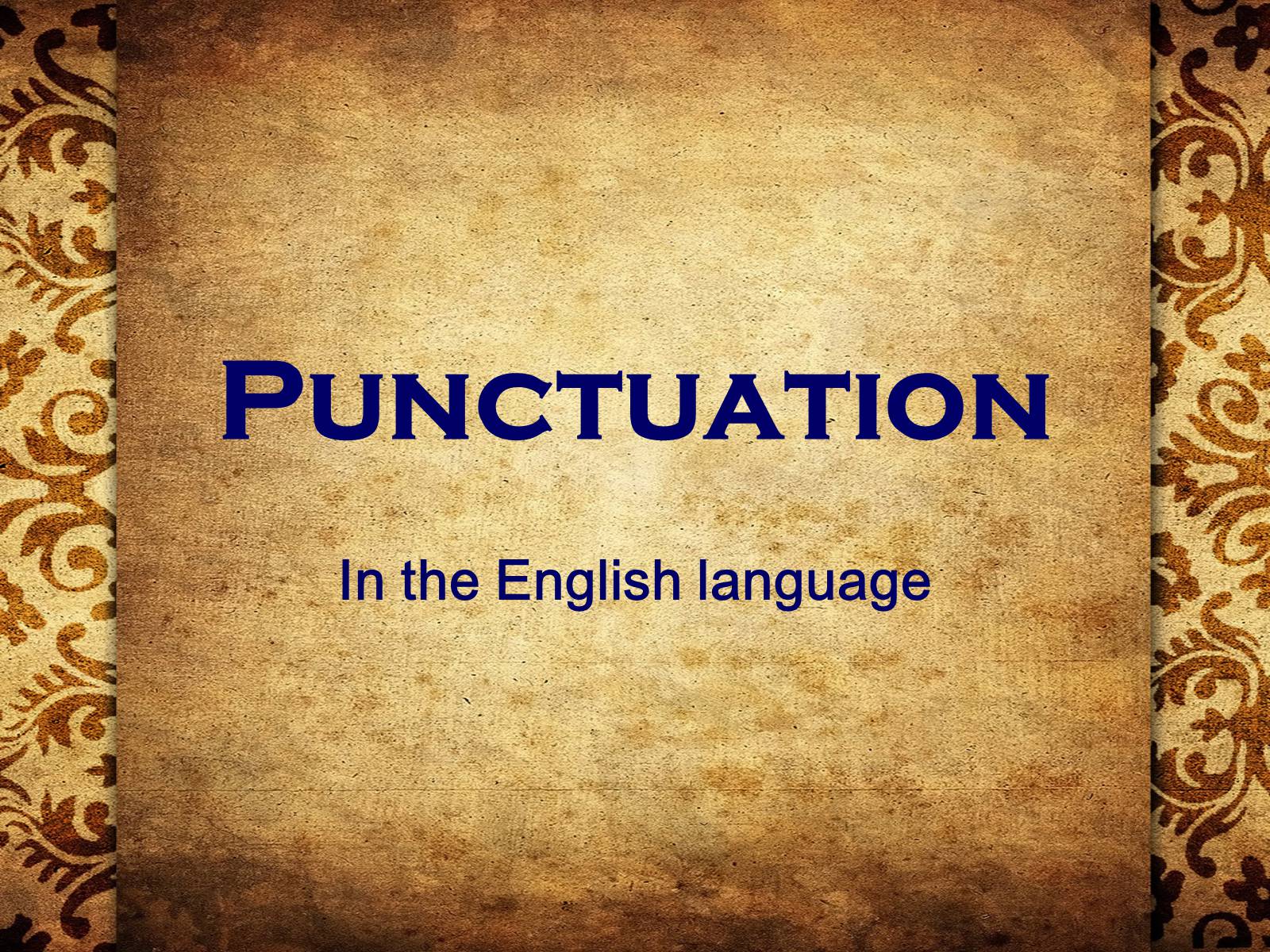Презентація на тему «Punctuation»

Punctuation
In the English language

Outline
History of punctuation
Types of punctuation marks
How to use them
Comma
Semicolon
Colon
Dash
Hyphen

A brief history of punctuation

The beginnings of punctuation lie in classical rhetoric - the art of oratory. Back in ancient Greece and Rome, when a speech was prepared in writing, marks were used to indicate where - and for how long - a speaker should pause.

Until the introduction of printing in the late 15th century, punctuation in English was decidedly unsystematic and at times virtually absent. Many of Chaucer's manuscripts, for instance, were punctuated with nothing more than periods at the end of verse lines, without regard for syntax or sense.

One of the first to codify the rules of punctuation in English was the playwright Ben Jonson, who included the colon (he called it the "pause" or "two pricks") in his signature. In the final chapter of The English Grammar (1640), Jonson briefly discusses the primary functions of the comma, parenthesis, period, colon, question mark, and exclamation point

Modern punctuationMain types of punctuation marks
End Punctuation: Periods, Question Marks, and Exclamation Points
Commas
Semicolons
Colons
Dashes
Hyphens

Commas
The most popular mark of punctuation, the comma(,) is also the least law-abiding. In Greek, thekomma was a "piece cut off" from a line of verse--what in English today we'd call a phrase or a clause. Since the 16th century, comma has referred to the mark that sets off words, phrases, and clauses.
,

Using the comma
Use a comma before a coordinator (and, but, yet, or, nor, for, so) that links two main clauses: "The optimist thinks that this is the best of all possible worlds, and the pessimist knows it.“
Use a Comma to Separate Items in a Series: "It is by the goodness of God that in our country we have three unspeakably precious things: freedom of speech, freedom of conscience, and the prudence never to practice either of them.“
Use a comma after a phrase or clause that precedes the subject of the sentence: "When you get to the end of your rope, tie a knot and hang on.“
Use a pair of commas to set off words, phrases, or clauses that interrupt a sentence: "Literature is all, or mostly, about sex."

How NOT to use the comma
Do not use a comma to separate the subject from its predicate:
[WRONG] Registering for our fitness programs before September 15, will save you thirty percent of the membership cost.
Do not misuse a comma after a co-ordinating conjunction:
[WRONG] Sleet fell heavily on the tin roof but, the family was used to the noise and paid it no attention.
Do not use a comma before the first item or after the last item of a series:
[WRONG] You should practice your punches, kicks and foot sweeps, if you want to improve in the martial arts.

How NOT to use the comma
Do not use a comma to separate the subject from its predicate:
[WRONG] Registering for our fitness programs before September 15, will save you thirty percent of the membership cost.
Do not misuse a comma after a co-ordinating conjunction:
[WRONG] Sleet fell heavily on the tin roof but, the family was used to the noise and paid it no attention.
Do not use a comma before the first item or after the last item of a series:
[WRONG] You should practice your punches, kicks and foot sweeps, if you want to improve in the martial arts.

Semicolon
A mark of punctuation ( ; ) used to connect independent clauses and show a closer relationship than a period does.
;

Using the semicolon
Examples
“Happiness isn't something you experience; it's something you remember.”
“Volleyball games resume on the sand flat; someone fires up the sauna; in the long dusk, at eleven o'clock, half a dozen beach fires people the shore.”
“Management is doing things right; leadership is doing the right things.”

Colon
A mark of punctuation (:) used after a statement (usually anindependent clause) that introduces a quotation, an explanation, an example, or a series.
:

Using the colon
Examples:
“I have never made but one prayer to God, a very short one: 'O Lord, make my enemies ridiculous.' And God granted it.”
“There are three choices in this life: be good, get good, or give up.”
“It is by the goodness of God that in our country we have those three unspeakably precious things: freedom of speech, freedom of conscience, and the prudence never to practice either of them.”

Dash
A mark of punctuation (—), technically known as an em dash, used to set off a word or phrase after an independent clause or to set off words, phrases, or clauses that interrupt a sentence. Don't confuse the dash with the hyphen (-).
—

Using the dash
Examples:
“My cow turned out to be a very large one. The first time I led her out I felt the way I did the first time I ever took a girl to the theater-embarrassed but elated.”
“A hypocrite is a person who-but who isn't?”
“A dash is a mark of separation stronger than a comma, less formal than a colon, and more relaxed than parentheses.”

Hyphen
A short horizontal mark of punctuation (-) used between the parts of a compound word or name or between the syllables of a word when divided at the end of a line.
-

Using the hyphen
“The hyphen is the most un-American thing in the world.”
“New truth is always a go-between, a smoother-over of transitions.”
“I'm part of the blame-America-last crowd.”

Conclusion
Remember: Punctuation is being governed two-thirds by rule and one-third by personal taste :)And don't forget that proper punctuation is 5% of your IELTS score

The EndThank you for your attention!